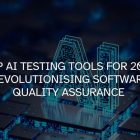Whether you’re a product owner, QA lead, or a tech visionary, choosing the right AI testing tools for 2025 could be the game-changer for your success.
Are Manual and Traditional Automation Tools Failing You?
Let’s face it. Manual testing is time-consuming, prone to human error, and doesn’t align with today’s DevOps and Agile practices. Even traditional automation tools require constant script maintenance, can’t adapt easily to UI changes, and often struggle to deliver value in fast-paced environments.
That’s where AI automation testing tools come into play—bringing self-healing scripts, visual validation, predictive analytics, and faster test cycles. We at Shvintech have seen firsthand how these tools are closing the gap between development and quality assurance.
Why AI in Software Testing Is the Future (2025 and Beyond)
The rise of Generative AI testing tools, predictive defect detection, and intelligent test orchestration is no longer futuristic—it’s the new normal. In 2025, AI tools for software quality assurance will be indispensable for:
- Accelerating time-to-market
- Reducing costs and redundant testing efforts
- Enhancing test coverage with minimal human input
- Improving defect detection through machine learning insights
From startups to global enterprises, organizations are now searching for the best AI testing tools to stay ahead of the curve. But with so many options, where do you begin?
Our Curated List: Top AI QA Tools & Frameworks for 2025
Here’s our expert-picked automation testing tools list leveraging cutting-edge AI capabilities, both open source and commercial.
- Testim by Tricentis
- Why It Stands Out: Self-healing tests, smart locators, intuitive UI
- Use Case: Web and mobile test automation
- Bonus: Integrates well with CI/CD pipelines like Jenkins, CircleCI
- Category Tags: top AI QA tools, QA automation tools with AI

- Applitools Eyes
- Why It Stands Out: Visual AI for automated UI regression testing
- Use Case: Pixel-perfect UI validation
- Bonus: Works across frameworks (Selenium, Cypress, etc.)
- Category Tags: AI in software testing 2025, top software testing tools using AI

- Mabl
- Why It Stands Out: Auto-maintained tests, performance analytics
- Use Case: DevOps-centric environments
- Bonus: Built-in performance testing with AI-backed insights
- Category Tags: AI automation testing tools, next-gen AI testing frameworks

- Functionize
- Why It Stands Out: NLP-based test creation, auto-maintenance
- Use Case: Cloud-first QA teams
- Bonus: Fast parallel execution
- Category Tags: best AI testing tools, AI tools for software quality assurance

- Katalon Studio with AI Add-ons
- Why It Stands Out: Hybrid testing, AI-powered test ops
- Use Case: API, mobile, web, and desktop automation
- Bonus: Extensive plugin library and open-source flexibility
- Category Tags: ai testing tools open source, QA automation tools with AI

- Sofy.AI
- Why It Stands Out: Scriptless testing for mobile apps
- Use Case: Fast, real-device testing
- Bonus: Integrates with JIRA, Slack, and CI/CD
- Category Tags: free ai testing tools, top ai testing tools

- TestCraft (by Perforce)
- Why It Stands Out: AI-powered Selenium testing platform
- Use Case: Business testers & automation engineers
- Bonus: Real-time dashboards, easy maintenance
- Category Tags: top software testing tools using AI, which automation tool is in demand 2025

- Virtuoso
- Why It Stands Out: Generative AI-powered natural language scripting
- Use Case: Non-tech teams creating robust tests
- Bonus: Web and API support with self-healing tests
- Category Tags: generative ai testing tools, top AI Testing Tools for 2025

- AutoAI (IBM Watson Studio Integration)
- Why It Stands Out: ML-driven predictive analytics for QA
- Use Case: Enterprise-grade quality management
- Bonus: Predict failures before they happen
- Category Tags: AI testing tools 2025, AI in software testing 2025

- Open Source Alternatives
- Tools to Explore:
- Sahi Pro
- Intelligent record-playback with AI enhancements

- OpenTest
- Test automation platform with basic AI logic

- Robot Framework + AI Libraries
- Customizable open-source QA

Category Tags: ai testing tools open source, free ai testing tools
Key Benefits of Using AI in QA (Backed by Real Business Impact)
Reduced Test Maintenance by 60–80%
AI-powered tools adapt to UI changes and use dynamic locators to heal broken scripts automatically.
Increased Test Coverage
With ML models, you can identify untested paths and user behaviors that would otherwise go unnoticed.
Faster Feedback Loops
AI tools integrate tightly with DevOps pipelines to provide near real-time feedback during CI/CD cycles.
Cost Efficiency
Reduce manual QA efforts, minimize rework, and avoid missed bugs in production—all leading to better ROI.
Choosing the Right Tool: What Should You Consider?
- Team Skill Level: Some tools require programming, others are low-code/no-code
- Tech Stack Compatibility: Make sure the tool works with your app’s environment
- Integration Capabilities: Look for compatibility with your CI/CD, test management, and bug tracking tools
- Licensing & Support: Evaluate if free AI testing tools or open-source options meet your scalability needs
- Scalability: Can it grow with your product, user base, and QA scope?
Ready to Explore AI for Your Testing Strategy?
We at Shvintech specialize in helping businesses adopt the right AI-powered QA automation tools that align with their goals, infrastructure, and timelines. Our consulting experts can guide your team through tool selection, integration, training, and test strategy—all customized to your roadmap.
Let’s talk about how AI can elevate your QA lifecycle.
Book a discovery call with our AI testing specialists today!
Contact Shvintech | Schedule a Free QA Assessment Call
The Future: Where AI Testing is Headed in 2025 and Beyond
1. Generative AI for Test Script Creation
What it means:
Generative AI (like GPT models) can automatically generate test scripts from natural language instructions, user stories, or application flows.
Example:
Instead of a QA engineer writing Selenium scripts manually, they could input:
“Test the login page with valid and invalid credentials.”
The AI would then auto-generate the test script, complete with assertions and test data.
Benefits:
- Faster test creation
- Low-code or no-code approach
- Accessible to non-technical users (e.g., product managers, BAs)
- Reduces scripting errors
2. Predictive Testing with LLM-Powered Defect Analysis
What it means:
Large Language Models (LLMs), like those behind ChatGPT, can analyze historical defect data, test logs, user behavior, and code changes to predict areas in the application most likely to break.
Example:
Based on your code changes, the AI predicts that a payment gateway component is likely to fail due to previous bug patterns and dependencies.
Benefits:
- Focus testing efforts on high-risk areas
- Prevent bugs before they happen
- Prioritize regression tests more intelligently
- Reduce time and cost in test planning
3. Hyper-Automation of Test Ops Using AI Agents
What it means:
Hyper-automation involves automating not just test execution but the entire testing lifecycle—including planning, scheduling, maintenance, environment setup, and reporting—using AI agents or bots.
Example:
An AI agent detects a nightly code deployment, auto-selects impacted tests, provisions test environments, runs the tests, and sends a dashboard summary with risk scores to the team—all without human intervention.
Benefits:
- End-to-end automation
- Reduced manual QA overhead
- Better scalability for large releases
- Faster feedback loops in CI/CD pipelines
4. Real-Time Decision-Making Through AI-Driven Dashboards
What it means:
Dashboards enhanced by AI don’t just display data—they analyze and recommend actions based on test results, trends, and metrics.
Example:
An AI-powered dashboard flags a drop in performance for a recent build, links it to a specific code commit, and suggests rollback or additional tests.
Benefits:
- Smarter insights, not just charts
- Quick, data-driven decisions
- Improved collaboration between QA, Dev, and Ops
- Greater test visibility and accountability
5. End-to-End Autonomous Testing
What it means:
This refers to a fully automated system where AI manages the entire testing lifecycle—from test creation and maintenance to execution and reporting—without the need for constant human supervision.
Example:
In an e-commerce app, an AI system continuously learns user behaviors, adapts test cases, executes them in real-time, and evolves testing strategies as the product grows.
Benefits:
- Continuous testing without human input
- Resilience to frequent product updates
- Ideal for agile, DevOps, and shift-left testing
- Massive cost and time savings
The shift from traditional QA methods to next-gen AI testing frameworks isn’t optional anymore—it’s inevitable. Embracing AI automation testing tools not only optimizes your testing efficiency but also enhances product reliability and user trust.
At Shvintech, we’re committed to enabling smarter, faster, and more scalable quality assurance. With the right AI tools, you can deliver future-proof software—confidently and consistently.






